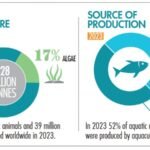Washington, D.C.- Bangladesh’s recent aquaculture growth has defied predictions so much that it deserves to be called a “Blue Revolution.” Even though aquaculture has enabled over 2 million Bangladeshis to escape poverty from 2000-2010, the country’s fisheries policy has yet to adapt to these changes. Creating greater access to fish as a source of nutrition among poor households in the future will require policy reforms and targeted investments. These are some of the key findings of a new book from researchers at the International Food Policy Research Institute (IFPRI) and their collaborators.
The book, The Making of a Blue Revolution in Bangladesh: Enablers, Impacts, and the Path Ahead for Aquaculture, co-edited by IFPRI’s Shahidur Rashid and Xiaobo Zhang, provides the evidence needed to improve aquaculture policies in Bangladesh. The book, based on the first comprehensive survey of the primary fish value chain in the country, examines three broad aspects of Bangladeshi fish aquaculture’s transformation: the determinants of value-chain transformation; the impacts of the transformation on poverty and food security; and the medium-term prospects for aquaculture in Bangladesh.
“Bangladesh is an excellent case study for the role of fisheries in food security,” said IFPRI Director for South Asia and study co-author Shahidur Rashid. “Contrary to assumptions that nutrient-rich foods will remain out of reach for the poor, the story of fish aquaculture in Bangladesh shows how nutrient-rich food can become more widely available for all.”
The share of fish aquaculture or ‘pond culture’, that is, cultivation of fish in ponds, both for household and commercial consumption, in fish production increased from 30 percent to 47 percent from 2000 to 2015. Improved technology, infrastructure and information lowered transaction costs; and this combined with value-chain innovation, spurred the commercialization of ‘pond fisheries.’ Between 2000 and 2010, fish consumption in both rural and urban areas increased from 13.4 kg to 18.1 kg; while prices of the farmed fish dropped by 12 percent during the same period, despite an increase in the population and demand for fish, according to the book.
Despite concerns among development specialists that aquaculture might increase economic inequality, researchers found that aquaculture not only led to employment generation, but also had a positive effect on the welfare of all income groups. Growth in aquaculture has been responsible for almost 10 percent of the overall poverty reduction in Bangladesh during 2000-2010. In other words, of the 18 million Bangladeshis who escaped poverty during 2000–2010, more than 2 million of them managed to do so because of aquaculture.
“We’ve seen that consumption has grown more equitably than expected,” said Rashid. “Fish consumption has grown across lines of gender and income, with poorer households experiencing higher growth than other groups.”
Md. Raisul Alam Mondal, Bangladesh’s Secretary of the Ministry of Fisheries and Livestock said the book is “a compelling set of analyses on aquaculture in Bangladesh that is rigorous, relevant and timely”. “Bangladesh is committed to developing fisheries sector in a sustainable manner; and significant investments are being made to achieve that objective,” he said. “I believe that the analytical frameworks and findings of the book will prove useful in policy making.”
Stay Always Informed
Join our communities to instantly receive the most important news, reports, and analysis from the aquaculture industry.
The authors also project that given increased aquaculture investment and productivity, fish production will continue to grow through 2030 and outpace demand. “With the right targeted investments, poor households will benefit from even lower farmed fish prices,” added Rashid.
The book sheds light on several factors that have driven the aquaculture’s transformation, namely improved technology, reduced transaction costs, and value-chain innovation. Modern fish varieties and post-production marketing, better infrastructure and geographic “clustering” of fish production and marketing activities are just some of the components leading to greater productivity. Most importantly, years of sustained economic growth have fueled domestic demand, which has been a crucial factor in growing the domestic fish market.
The Making of a Blue Revolution in Bangladesh presents implications for Bangladeshi aquaculture’s productivity and market expansion. “Aquaculture still has a huge potential and could achieve a twelve-fold increase if intensive fish farming were expanded from its current, limited scope to even half of Bangladesh’s pond area,” said IFPRI Senior Research Fellow and study co-author Xiaobo Zhang.
Once productivity improves, the next step is to sell fish in international markets. However, tapping into international markets would require updating Bangladesh’s fisheries policy and regulations, including data, which have lagged behind aquaculture’s technological improvements and value-chain innovations, said Zhang. With those improvements, Bangladesh’s full potential for growth in aquaculture productivity can be realized.
Reference (open):
Rashid, Shahidur; Zhang, Xiaobo, (Eds.). 2019. The making of a blue revolution in Bangladesh: Enablers, impacts, and the path ahead for aquaculture. Washington, DC: International Food Policy Research Institute (IFPRI). https://doi.org/10.2499/9780896293618 http://ebrary.ifpri.org/cdm/ref/collection/p15738coll2/id/133348
Editor at the digital magazine AquaHoy. He holds a degree in Aquaculture Biology from the National University of Santa (UNS) and a Master’s degree in Science and Innovation Management from the Polytechnic University of Valencia, with postgraduate diplomas in Business Innovation and Innovation Management. He possesses extensive experience in the aquaculture and fisheries sector, having led the Fisheries Innovation Unit of the National Program for Innovation in Fisheries and Aquaculture (PNIPA). He has served as a senior consultant in technology watch, an innovation project formulator and advisor, and a lecturer at UNS. He is a member of the Peruvian College of Biologists and was recognized by the World Aquaculture Society (WAS) in 2016 for his contribution to aquaculture.




